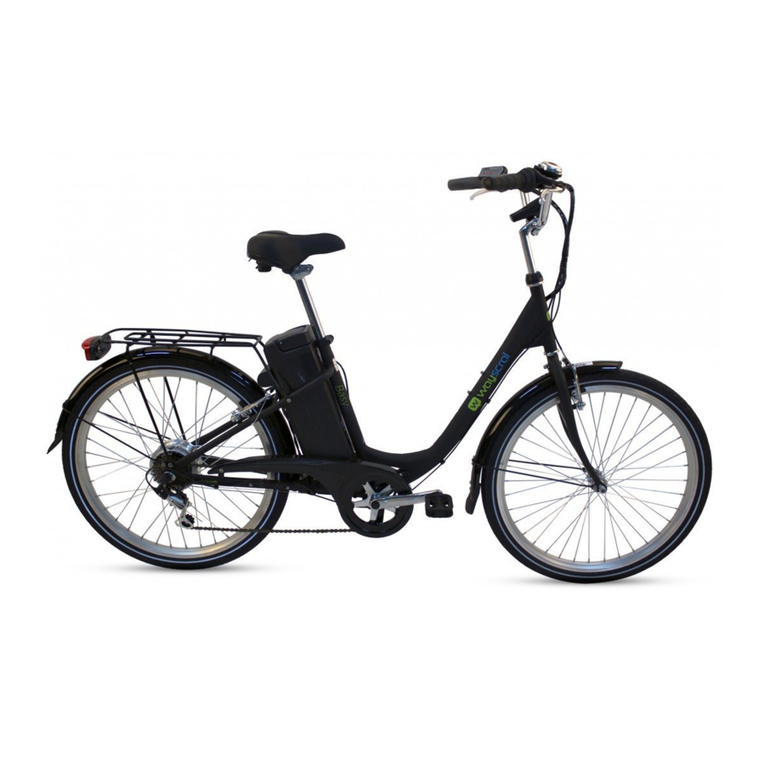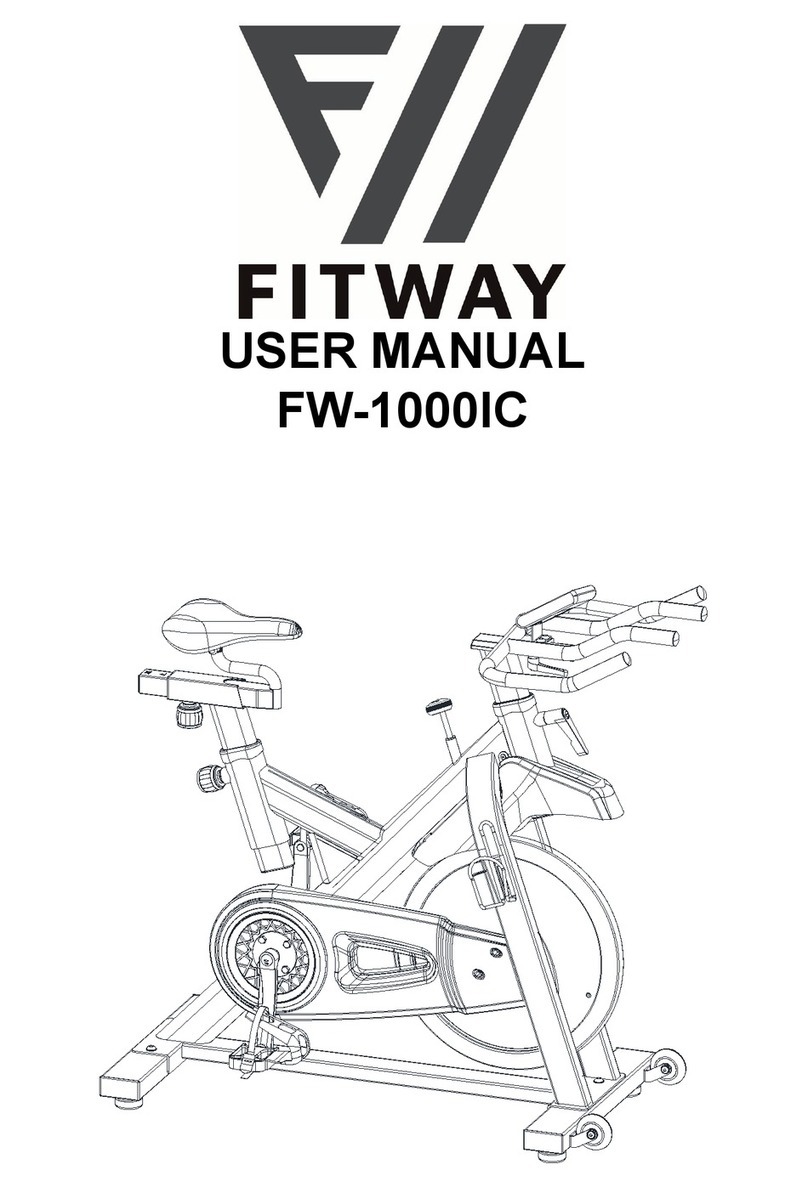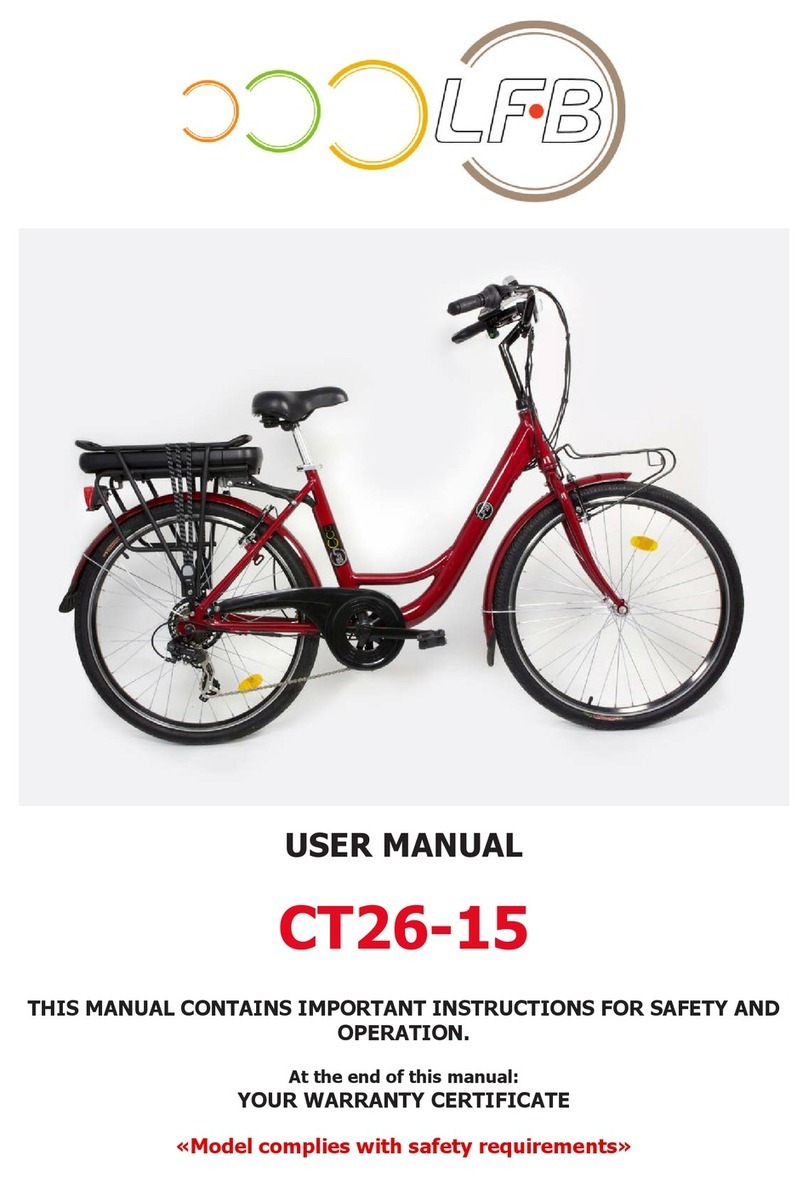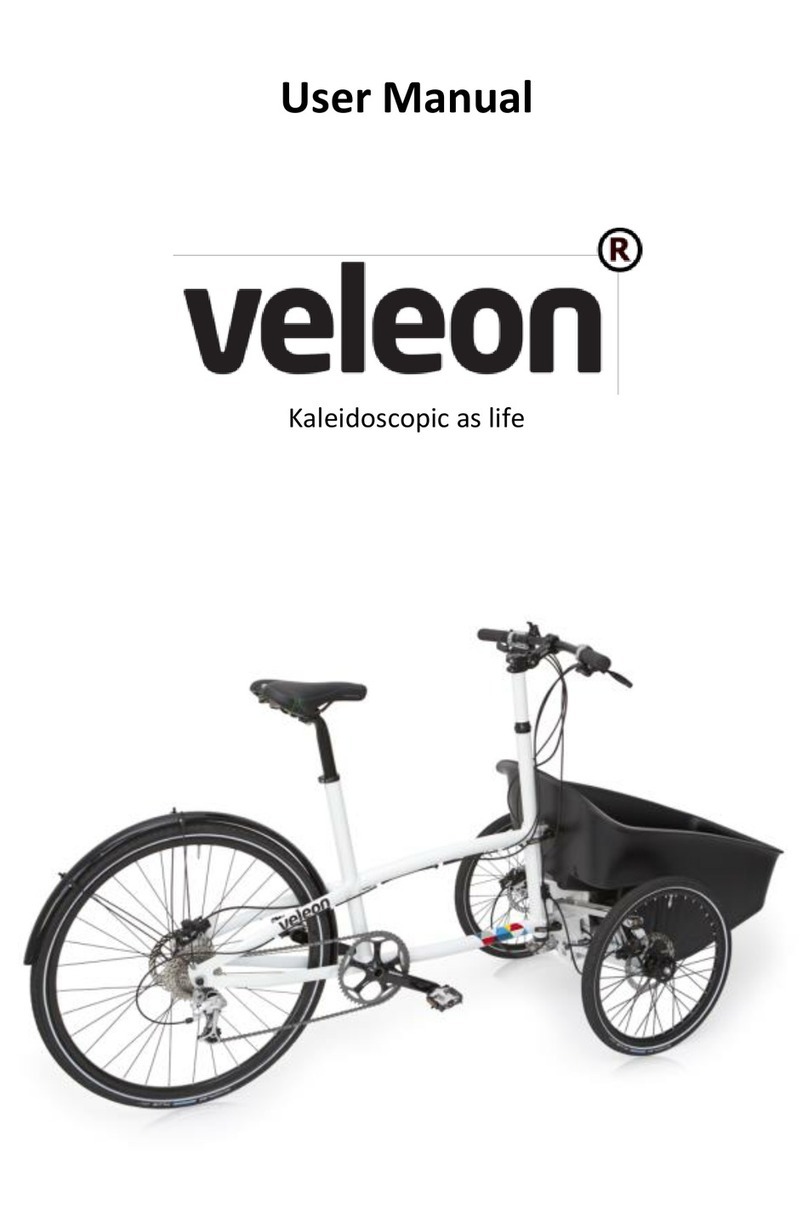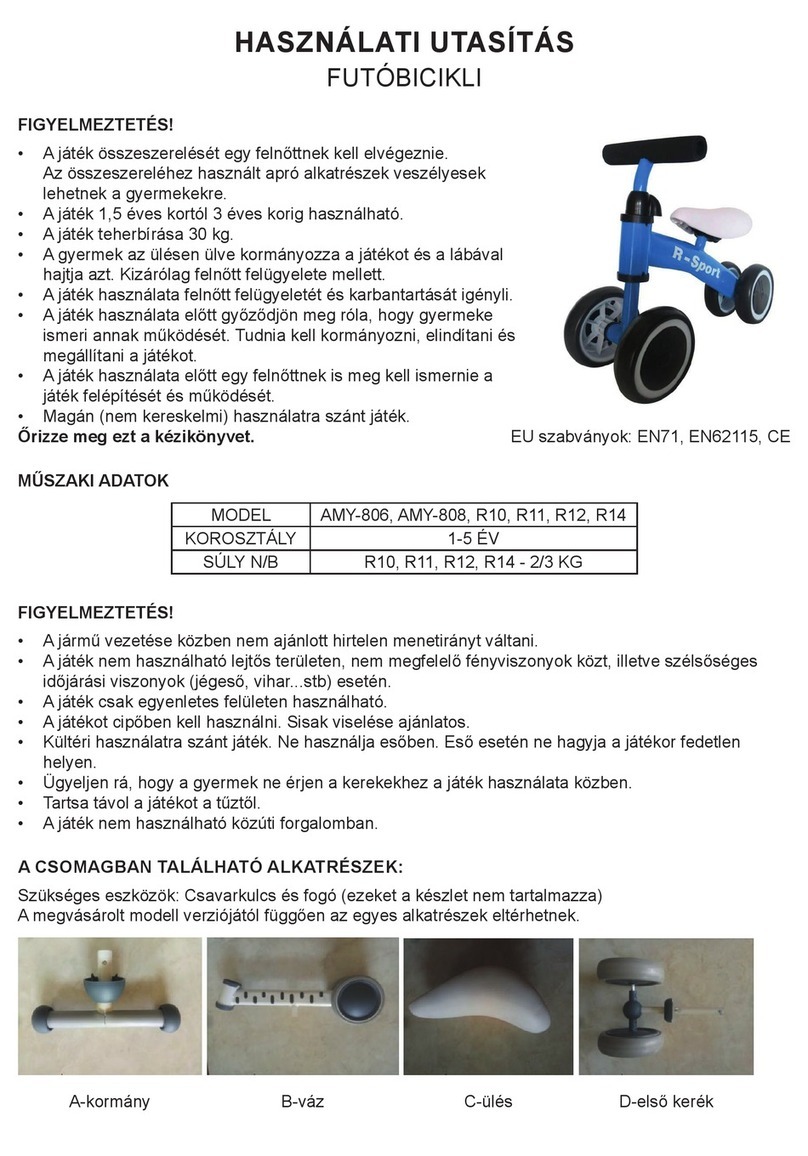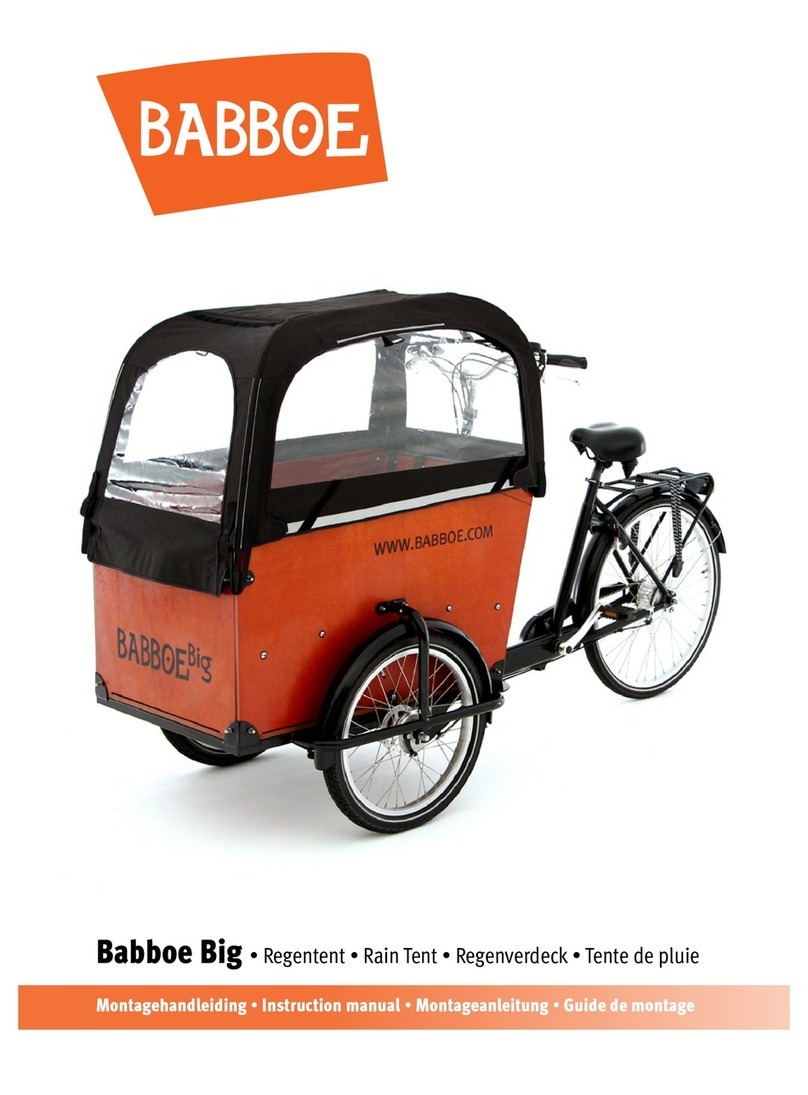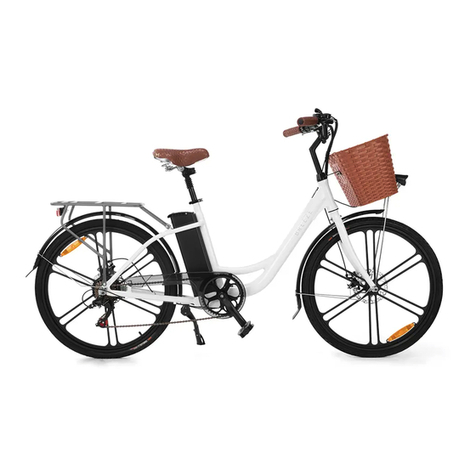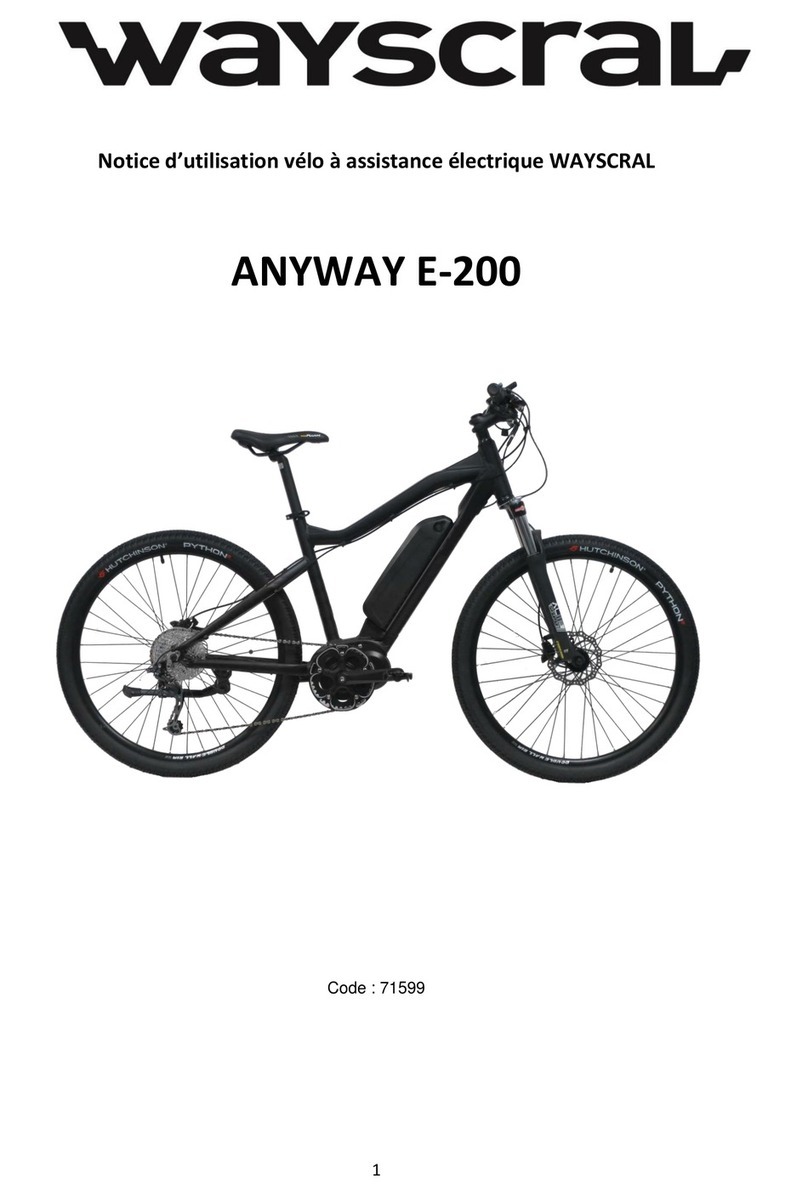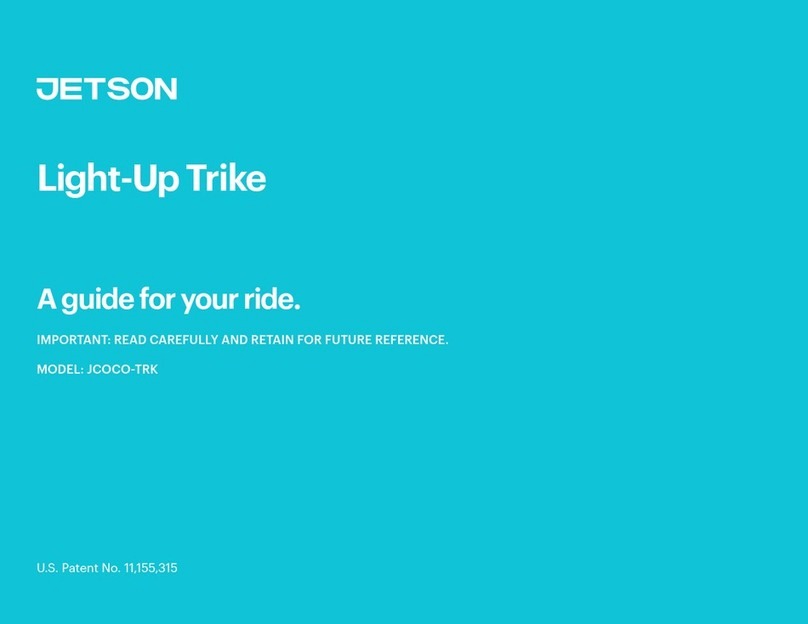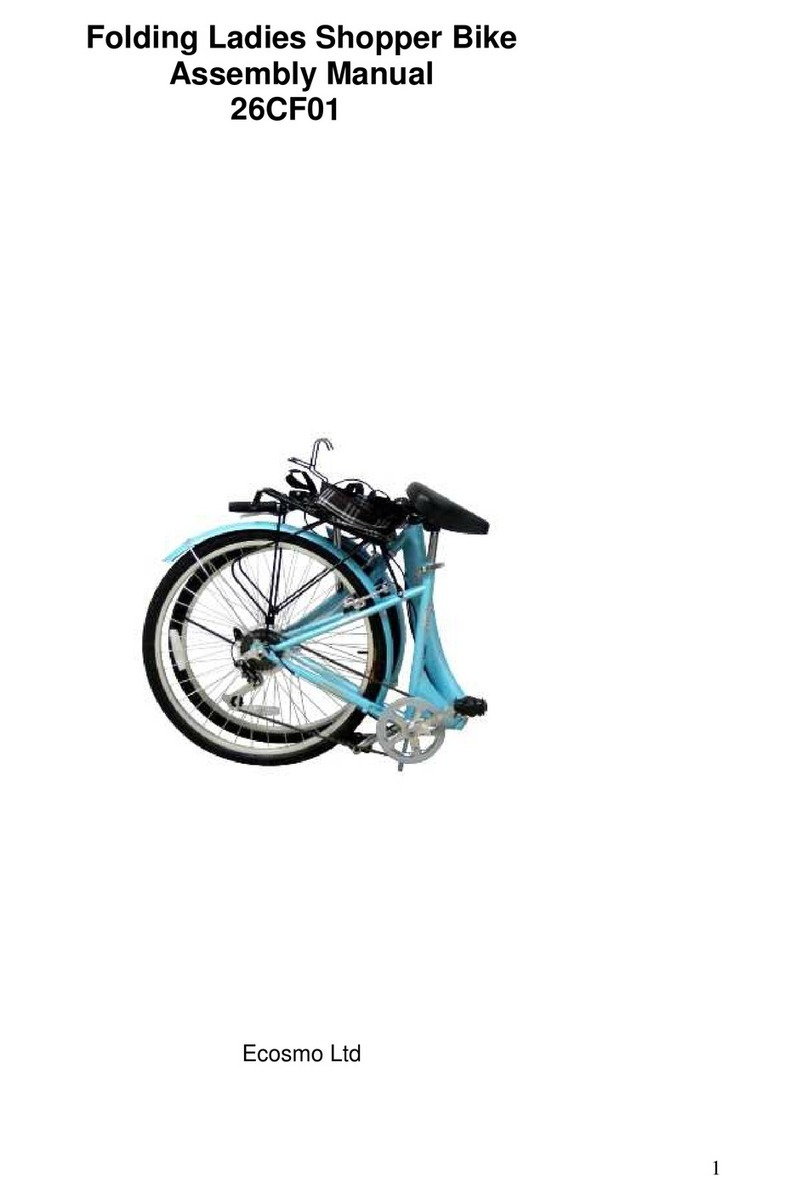Linear Aluminum Recumbent Bicycle User manual

LFlffiE&R
MA]IUFAGTURII{G,
IIIG
.
AtUMIilUMREGUMBEilT
BIGYGTE
OWIIER'SMANUAL
LINEAR
MANUFACTURING
INC.,
32744
KESTREL
AVE.
GUTTENBERG
IA
52052,
PH.
319-252.1637

OWNER'S
RESPONSIBILITY
IT ISTHEOWNER'S
RESPONSIBILITYTO:
(1)
Be
certain
thatallassembly
instructionshave
been
followed.
(2)Makeall
necessaryadjustments.
(3)
Carefully
readand
follow
safe
ridingrules.
(4)
Checkout
your
recumbentbefore
riding.
(5)Performall
required
maintenance.
(6)
Knowhowtooperate
allstandardandaccessory
equipmenton
your
recumbent.
(7)
Makecertain
thatanyone
usingthe
recumbenthas
been
fullyinstructedinits
operation.
(8)
Conform
toallapplicable
traffic,registrationandequipment
laws.
Only
youwill
be
responsible
forany
damage
tothebicycleor
injurytothe
rideriftheserules
are
not
followed.
2

SAFE RIDING
RULES
Every
bicycle
rider
shouldknowthe
difference
betweentheright
way
ofriding
andthe
wrong
way.Too
oftenthe
inexperienced
bicyclerider
usesunsaferiding
techniques
or
tries
stunt
riding,
and
the
usual
resultis
afallalongwith
possible
injury.
Yourrecumbent
is
designed
forenjoyable
usein normalriding
conditions,notfor stuntsor experimentation.
Also,
remember
that
proper
clothingisnecessary
tor
safe
riding.
Whenriding,
always
wear
shoes,
avoidloosefitting
clothing,andwearlight
colorswhenriding
in
the
eveninghours.
Useonly
accessories
suited
foryour
bike.Thefollowing
rules
arerequired
bylaw
inmany
areas.
Check
your
local
law
enforcementagencyregarding
these
andany
additional
rules
that
may
apply
to
you.
1. Obey
allapplicable
vehicle
operation
laws,
trafficregulations,
signs,
signals,
and
markings.
2. Whenever
you
ride
alone,ride
ontherighthand
sideoftheroad.
When
riding
in
pairs
orlarge
groups,
ride
singlefile
alongthe
righthand
sideof
theroad.
Setup
asensible
distance
between
yourself
andtherider
infront.
Don'tweave
in
andout.
Don't
tailgate.
3. Be
extremelycarefulatallintersections.
Walk
your
bikeacross
busyintersections,
and
watchfor
cars
when
making
aturn.
4. Watch
out
for
cardoorsopening
orfor
cars
pulling
outinto
traffic
from
streets,
alleys,
anddriveways.
5. Use
proper
hand
signalstoindicate
turnsor
stops.
Get
in
thehabit
of
always
signaling
soitwill
becomeanautomatic
reaction.
Keep
bothhands
on
thehandlebars
except
when
giving
hand
signals.
6. Watch
out
for
drain
grates,
softroad
shoulders,
andother
roadhazards.
7. Be
awareofridingconditions
when
operating
your
bicycleon
oroffthe
road.
Be
extra
cautiouswhenridingonwet
pavement,
gravel,
orleaf-covered
pavements.
ltwill
take
more
distancetostop
your
bicycle
when
ridingon
these
types
ofsurfaces,
and
your
bikemay
skid
in
a
turn.
8. Never
carry
passengers
-except
in
aprotective
childcarrier
properly
mounted
to
maintain
safecontrolof
bicycle.
Never
carry
packages
thatinterfere
with
your
vision
or
control.
Always
givepedestrians
theright
ofway.
Always
ride
onmarked
bikeways
where
avail-
able.
(Check
local
ordinances
regarding
riding
bikesonroadways
and
sidewalks.)
Most
accidentshappen
atdusk.Be
doubly
carefulwhen
riding
during
thesehours.
Make
certain
your
bicycle
complieswith
local
equipment
laws
fornight
operation.
Drive
asafebike.Always
keep
your
bicyclein
good
mechanical
condition.
For
instruc-
tions
on
Operation,Adjustment
andMaintenance,
see
the
appropriate
sections
of
this
manual.
Ride
your
bike
defensively;
watch
outfor
other
vehicles.
Always
wearan
approved
helmet,
even
on
shortrides.
Helmets
can
greatly
reduce
the
chances
ofinjuryin
many
types
of
accidents.
9.
10.
11.
12.
13.
14.

LINEAR
ALUMINUMRECUMBENT
BICYCLE
CLWB
OWNERS
MANUAL
NOte: intheinstructions,
right
and
lefthand
sidesofthebike
areas
you
would
beseated
inthe
riding
position
onthebike.
Toolsneeded:
3&Smm
hexkey
(allen
wrench)
15mm
wrench
(or
adjustable
wrench)
1. Upon
receiving
your
bike,carefullyopentheshipping
cartonandexaminethecon-
tents.Youshould
find
several
assemblies,theframe/handlebar,wheels/tires,
seat,
andsteering
link,and
Linear
bag
withreflectors,
pedals,
shifterchain,rack
adapter
ifordered.
Theorderof
assembly
isn'timportant.You
maychoosetomountthewheels
and
tiresfirstso
that
theframedoesnot
get
scratched
bythefloor.
2. MOUNTING
THEWHEELS- lf
you
have
a
quick
release
brakedothe
following.
Release
the
rear
brake
assemblysothatthe
wheel
andtire
willfit
throughitmore
easily.
Using
your
hand,squeeze
the
brake
pads
togetherandusing
your
other
hand,
pull
downward
and
outward
onthecable
releaselever
(the
smallsilver
lever
onthe
righthand
side
ofthebrake
assembly
wherethe
cablecomes
into
the
unit).
The
cable
DOESNOT
have
to
be
loosened
to
accomplish
thisstep.This
method
of
releasingthe
brakes
will
be
neededif
you
ever
havea
flat
or
need
to
remove
the
wheel/tirefrombike.Thefrontwheel
goes
intothefront
forkinaconventional
mannerusingthe
quick
release
skewerto
hold
it
in
place.
The
rearwheel
goes
intotheslotson
therear
"drop
outs"
(the
curved
part
of
the
framethat
goes
downward
withthederailleur
mountedto
it).Be
sure
thewheelaxle
seats
intotheslotall
the
way
tothe
rear.The
lockwasher
goes
ontheoutsideof
theframe,
just
under
thenutthat
holdstheaxle
in
place.
This
prevents
thenutfrom
loosening
upandthe
axle
movingfonruard
intheframeslots.
Be
sure
totightenboth
nutsontherearaxleusing
the1Smm
wrench.
3. ADJUSTING
THE
SACHS
SIFTING/BRAKE
LEVERs-Adjustthe
angleof
the
brake
leversto
your
riding
styleand
comfort
thentightenthe
locking
clamps.
After
adjusting
thebrake
levers,
using
a3mm
hexkey,tighten
the
Sachsshiftersonthe
handlebarsso
theywillnotrotate.
To
adjust
theSachs
shifter
for
the
rear
hub,twistthe
shifteronthe
lefthandlebartothe
"3"
(highestgear)
position.
Take
thecablethatrunsto
the
rear
hub
(the
one
with
thesmall,black
blockonit).
Make
surethechaincomingoutof
the
hub
isfully
"relaxed"
with
no
tensionon
it.Takingtheblackblockin
one
hand
andthe
chain
in
theother,simplyslide
the
chain
intothe
blockuntilallslack
isremoved.

This
shouldbe
properly
adjusted
forshifting.
Toremove
this
block
(for
wheel/tire
removal
orreadjustment)
press
onthe
small,
silverbar
ontheblock
while
pulling
the
chain
outof
the
block.Thesilverbar
isarelease
mechanism.
NOTE:
The
threaded
end
of
theadjuster
chainDOESNOT
SCREWINTO
THE
BLOCK;it
simply
slidesin
andisheld
in
place
by
themechanism.
4. MOUNTING THE SEAT -The
seatassemblyis
mounted
to
theseat
adjuster
blockusing
the
quick
release
skewer.
Line
upthe
holes
in
thefront
seatmount
with
the
holesinthe
adjusterblockand
insert
theskewer
intothe
seatmount
from
theright
hand
side.Theskewer
"nut"
goes
into
theleft
handside
ofthe
seatmount.
DO NOT
TIGHTEN THIS NUT YET! The
seatbraces
are
thenextitem
to
behooked
up.
Thebottom
endsoftherodshave"quick
connect"fittings
that
go
overthe
ballends
that
aremountedto
the
rear
frame
closeto
theaxlenuts.
Pull
upward
onthe
fittings
andslip
them
overtheballs.Release
thefittings
and
makesure
theslots
go
over
the"shank"
of
theballends.Thislocks
theseat
bracesinto
place.
lF YOU DO NOT LOCK
THEFITTINGS,
THE
BRACES
MAY
COMELOOSE
WHILE
RID-lNG! nfterinstalling
the
braces,
adjustthe
seatlocation
byremoving
the
quick
connect
pin
ontheadjuster
block,
move
theseatfonryard
or
backward
to
suit
your
riding
styleandsize,replace
the
pin
in
the
adjusterblock,
andtighten
the
skewer.
NOTE:
Put
lever
onskewer
pointing
down
ortotherear
toeliminate
the
possibility
ofhitting
your
leg
onit.
Use
asmallcable
tiearound
therearderailleurcable
and
theright
seat
bracetokeep
the
cable
from
rubbingon
thetire.
(Do
nottighten
thecable
tie
- leave
itloose
enough
so
thatwhen
you
removeandreplace
theseat
you
canslip
thecable
tie
backonto
the
brace).
5. MOUNTINGTHE
STEERING
LlNK
-Thesteerins
tinkhas
a
"front"
&
"rear"
end.Thelarger
section
ofthetubing
goes
to
thefront.Pull
back
onthe
quick
release
fittings
at
the
end
ofthelinkand
put
theends
over
theballson
thefork
andhandlebars.
MAKE
SURE
FITTINGS
LOCK
ON
THE
BALLS!FAILURE
TOLOCK
THEM
MAY
ALLOW
THELINKTO
DROP
OFFWHILE
RIDING!
Afterinstalling
thelink,
adjust
the
length
tosuit
your
seat
position
by
pulling
the
quick
release
pin
in
thehandlebar
block
andin
the
link
andmoving
theblock
tothedesired
position.
Replace
the
pins
inthe
block
andlink
makingsurethey
go
alltheway
in.
Usingthe
Smm
hex
key,
tighten
thebolt
that
runs
throughthehandlebar
block
horizontally
atthefront
of
theblock.
There
isnoneed
toover-tighten
thisbolt,itonlyneeds
to
betightened
enough
tokeep
thehandlebars
from
feeling
"loose."
When
you
haveridden
your
bike
andhavefound
theright
position
for
the
seatandhandlebars,
you
may
experience
some
"rattling"
from
thesteering
link.
Toeli-
minate
this
noise,
makesure
theset
screwin
thecollar
onthe
steering
link
istightened.
lfthere
isstillsome
noise,look
at
theend
ofeach
ofthefittings
onthe
link
andfind
the
twoadjusting
setscrews
(one
oneach
end)
unless
you
have
aLinear
with
thenew
quick
release
endswhich
haveno
set
screws.
Using
the
3mmhex
key,
tighten
these
setscrews
insmall
increments
untilthe
"slack"
is
removed.
Ride
thebike
and
readjust
as
necessary.
5

hSIMPLE
GUIDELINES
FOR
PROPER
ADJUSTMENT
OF
QUICK
RELEASE
LEVERS
A.
MANUFACTURER'S
RECOMMENDATION
-
No
matter
whomade
thedevice,
always
follow,
and
instruct
your
customers
to
follow,
theadvice
given
inowner's
manuals
regarding
its
products.Most
QR
axles
will,
however,
operate
safely
and
securely
under
the
below
guidelines.
B.
EMBOSSING
THE
ENDS
-
When
properly
tightened,
the
metalof
the
QR
device
should
emboss
(make
a
visible
impression
in)thealuminum.
C.CURVED
LEVERS
-Almost
allQR
devices
havecurved
leversand
theconcave
side
should
face
thebicycle
when
itisinthe
closed
position.
D.
TIGHTENING
THE
DEVICE
-
With
the
lever
intheopen
position,
tighten
the
cone-shaped
nutat
theopposite
end
of
theaxle
so
that
when
moving
the
lever
toward
the
closed
position,
you
feelsome
resistance
to
motion
whenthe
lever
is
abit
past
thecenter
of
its
full
travel.Close
the
lever
all
theway
totheend
of
its
travel.
E.
TIGHTENING
FORCES
-While
the
lever
should
close
tight,do
notover
tighten:
too
tight
and
you
could
stretch
orotherwise
cause
damage.
Donotexert
more
than
45
pounds
force
(lbs.)
whenclosing
the
lever.
More
thanthis,and
you
willoverstress
the
Parts.
F.RELEASING
FORCES
-
Although
the
release
is
called
quick,
opening
should
notbe
too
easy.
The
lever
must
not
release
until
at
least
12lbs.of
forceare
applied.
Open
the
lever
and
tighten
thecone-shaped
bolt
some
more.
Repeat
the
process
until
the
minimum
opening
force
is
achieved.
Donotallow
the
levertobecome
so
tight
it
take
more
than
25lbf.
toopen
the
QR
device;
damage
couldresult
ifthe
lever
needs
that
much
force
toopen.
G.
MEASURING
NECESSARY
FORCE
-
Youdo
not
needcomplex
testing
equi-
pment
to
measure
your
exertion
of
force
on
the
QR
lever.
To
"educate"
yourself
on
how
much
12lbt.
feels,
push
on
abathroom
scale
or
asupermarket
produce
scale.
When
thescale
reads
12
pounds,
you'll
know
howmuch
force
you
will
need.
Remember:
The
lever
requires
at
least
12
pounds
of
opening
forceto
assure
ade-
quate
tightness
and
safety,
but
should
require
nomore
than
25
pounds
of
opening
force,
norshould
the
closing
forcebe
greater
than
45
pounds.
H.
FINAL
CHECKS
-While
the
final
position
of
the
lever
has
littleimportance
aero-
dynamically,
itshould
be
carefully
placed
toavoid
interfering
with
other
parts
or
accessories
or
with
the
operation
ofthe
bicycle.
Many
manufacturers
suggest
pointing
the
lever
rearward
to
avoid
snagging.
This
is
particularly
important
off-
road,
where
a
snag
ona
vine,branch
orother
protruding
object
may
pull
open
the
lever,
which
may
cause
loosening
and
failureof
the
product.
,
REPRINTED
FROM
AMERICAN
BICYCLIST'
6

The
Linear
CLWBis
a
great
piece
of
equipment....not
onlydesign,
but
workmanship
as
well.
There
arenot
many
"accessories"
that
you
need
otherthan
those
that
you
would
use
ona"wedgie,"
bag,
pump,
etc.
TIPS/MODIFICATIONS-
ADJUSTING
SEAT
ANGLE
-
WERECOMMEND
THAT
YOU
DO
NO
CUTYOUR
RODS,
ANDTO
PURCHASE
THEM
DIRECTLY
THROUGH
US
ORYOUR
BIKE
DEALER.
IF
YOU
START
CHANGING
THEDESIGN,
WARRANTY
WILL
NOT
APPLY.
YOU
CAN
ORDERADJUSTABLE
SEATRODS
BY
CALLING
LINEAR
ORYOUR
BIKE
DEALER.
TIRES
-
The
tiresthat
come
on
your
Linear
aresupertires.
lf
you
would
like
to
have
alittle
lessrolling
resistance
and
possibly
more
speed,
you
might
consider
changing
sizes
and
types
oftires.I
am
currently
usinga1
"
front
tire
byPrimo
and
a1
-3l8"
rear
tire
also
byPrimo.
Both
thesetires
are100PSl
tires
and
have
aherringbone
tread.
The
standard
rims
work
great,
no
need
tochange
anything.
WATERBOTTLE
CAGES/PUMPS
-
There
aretwo
places
that
you
can
easily
mount
cages
onthecompact
-
thetop
oftheframe
orthe
seatbraces.
You
cantap
thelast
seat
adjuster
hole
using
a1
14"x20tap,
drillanotherhole
to
correspond
with
the
otherhole
in
your
bottle
cageand
tapit,then
enlargethe
holesin
your
cagetofit1/4"
bolts
(we
recommend
button
head
allen
bolts
orallen
head
boltsfor
appearance).
Point
the
top
ofthe
cageto
thefront
sothatthe
bottleistilted
slightly
upward
onthe
bike.lf
you
prefer,
you
may
mount
the
cages
on
the
seat
braces.The
easiestmethod
is
to
usestainless
hose
clamps
(small
ones)
and
clampthe
cages
on
thefront,
side,
or
rear
ofthebraces
(by
using
them
pointing
toward
the
front
-lessreaching
to
get
tothem).
Tomount
apump,
asuggestion
would
beto
secure
ittothe
seat
brace
with
either
tiewraps
or
velcro
straps.Put
thehandle
endup
sothatit
doesn't
slidedown
and
hit
the
ground.
(Be
sureto
carryextratie
wraps
in
case
you
need
yourpump
and
have
toreplace
it
onthe
brace).
One
ofthe12
gram
cartridges
willinftate
oneofthe
small16"fronts
and
part
ofa20"
rear.lt's
handy
forfast,
tube
changing
flats.
REAR
VIEW
MIRROR
-Mirrors
are
a
necessity
because
itisnot
easyto
turn
around
and
look
over
your
shoulderas
ona
"wedgie."
ltis
alsonot
easyto
mount
amirror
onthe
Linear.
Helmet
mirrors
workwell,
too,
just
make
sure
you
usesomething
so
you
are
ableto
see
traffic
comingfrom
behind.
FAIRING
-
Werecommend
that
you
order
through
ZIPDESIGNS.
You
cantalk
to
Carl
by
calling
888-946
-7276.
7

RACK
ADAPTER
- Linear
modified
them
specifically
for
your
bike
depending
on
thesize.
Weuse
a
derailleur
block
and
a
tall
tube"
Mount
theblock
to
main
frame
ofthebike
behind
the
seat.
Astandard
rack
should
clamp
onto
the
post.
lTSHOULD
NEVERSLANT
DOWN
AND
RUBON
THE
WHEEL.
HEADLIGHT
MOUNT
-
Take
thecap
off
the
f
rontfork.
The
head
light
mou
nt
goes
there.
You
can
call
Linear
or
your
local
bike
shop
toorder
one.
CHAIN
IDLER
-
Mounts
on
the
frame
byunscrewing
a
single
bolt
to
widen
theblock.
Mount
itto
your
f
rame
and
screw
the
bolts
into
tighten
the
block.
Theblock
should
be
secure
and
not
move.Apply
the
lower
chain
over
the
topof
the
back
wheel.
BAR
ENDS
-Are
used
when
a
person
has
trouble
reaching
the
brakes.
Youcan
go
to
your
local
bike
dealer
to
purchase
them
and
have
them
installed'
8
Table of contents
